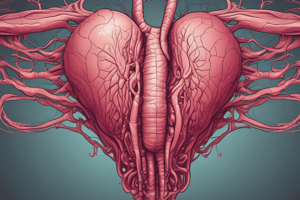Podcast
Questions and Answers
At what stage is the sex of the fetus distinguishable?
At what stage is the sex of the fetus distinguishable?
- By the end of the third month (correct)
- During the second month
- By the end of the first month
- During the fourth month
What reflex is present in the fetus during the third month of pregnancy?
What reflex is present in the fetus during the third month of pregnancy?
- Sucking reflex (correct)
- Rooting reflex
- Grasp reflex
- Moro reflex
What significant development occurs in the renal system during the third month?
What significant development occurs in the renal system during the third month?
- Urine production stops
- Kidneys become functional (correct)
- Formation of the kidneys begins
- Renal system is completely developed
What is the significance of the doppler by the end of the third month?
What is the significance of the doppler by the end of the third month?
What is one of the key functions of the placenta by the end of the third month?
What is one of the key functions of the placenta by the end of the third month?
During which month of pregnancy does quickening typically occur for a multipara mother?
During which month of pregnancy does quickening typically occur for a multipara mother?
Which structure in the fetus starts to form during the third month?
Which structure in the fetus starts to form during the third month?
What begins to happen to lanugo during the eighth month of pregnancy?
What begins to happen to lanugo during the eighth month of pregnancy?
What is the primary function of Wharton's Jelly in the umbilical cord?
What is the primary function of Wharton's Jelly in the umbilical cord?
What indicates an abnormal placental separation known as Duncan's mechanism?
What indicates an abnormal placental separation known as Duncan's mechanism?
At what stage does sex differentiation begin during pregnancy?
At what stage does sex differentiation begin during pregnancy?
What is a characteristic feature of the maternal side of the placenta?
What is a characteristic feature of the maternal side of the placenta?
When does the fetal heart start to beat rhythmically?
When does the fetal heart start to beat rhythmically?
What is typically not a feature during the 4th month of pregnancy according to common practices?
What is typically not a feature during the 4th month of pregnancy according to common practices?
What developmental milestone is achieved by the end of the second month of pregnancy?
What developmental milestone is achieved by the end of the second month of pregnancy?
Which substance is produced by the placenta during pregnancy?
Which substance is produced by the placenta during pregnancy?
Flashcards are hidden until you start studying
Study Notes
Wharton's Jelly and Placental Structure
- Wharton's jelly is a gelatinous substance cushioning the umbilical cord, located between three blood vessels.
- A decrease in Wharton's jelly makes the blood vessels more susceptible to compression.
- The placenta develops from chorionic villi and decidua basalis.
- At term, the placenta weighs approximately 500 grams and contains 15 to 29 cotyledons, which are checked after delivery.
- Hormones produced by the placenta include estrogen, progesterone, human placental lactogen (HPL), and human chorionic gonadotropin (HCG).
Maternal vs. Fetal Side of the Placenta
- Maternal side of the placenta is dark and reddish; abnormalities occur if lobes detach, leading to potential hemorrhage and inability of the uterus to contract.
- Fetal side is shiny and grayish.
- Two types of placental separation:
- Schultz: Separates from center to periphery, with fetal side seen first—normal delivery.
- Duncan: Separates from periphery to center, showing maternal side first—abnormal and may result in retained cotyledons.
Early Embryonic Development
- Rudimentary heart appears as a bulge on the anterior surface by 1-4 weeks.
- Arm and leg buds develop; spinal cord is formed and fused in the midline.
- Rudimentary facial features (eyes, nose, ears) are discernible.
Second Month of Development (5-8 Weeks)
- Sex differentiation begins, completing by the fourth month.
- Ultrasound may not accurately identify gender due to small genitalia.
- Fetus begins to assume a more human-like form.
- Amniotic fluid becomes present, aiding fetal development.
- Fetal heart rate can be measured by Doppler.
- Almost complete organogenesis occurs by the end of the month.
- Heart features a septum and valves, beating rhythmically.
- Abdomen starts to bulge due to intestinal growth.
- Presence of a gestational sac confirms pregnancy post-ultrasound.
Third Month of Development (9-12 Weeks)
- Renal system becomes functional.
- Sucking reflex allows the fetus to swallow amniotic fluid, which aids in gastrointestinal and renal development.
- The placenta is fully developed and functional.
- External sexual characteristics become distinguishable.
- Fetal heart tones can be detected by Doppler.
- Milk teeth buds and nail beds start forming; spontaneous movements are felt but are faint.
- Critical developments: heart functions as early as the 16th day; nervous system development linked to maternal glucose levels; sex differentiation begins in the second month.
Second Trimester Development
- The second trimester focuses on fetal length during development.
Fourth Month of Development (13-16 Weeks)
- Fetal heart tones can be detected using a fetoscope.
- Complete sex differentiation allows for gender identification.
- Quickening, or fetal movements, are felt by the mother around 16 weeks for multiparas; 5 months for primigravidas.
- Transfer of Immunoglobulin G (IgG) occurs from mother to fetus.
- Lanugo, fine hair covering the fetus, becomes well formed and begins to disappear by the 8th month.
- The liver and pancreas become functional.
- The fetus actively swallows amniotic fluid, which is also present in urine, leading to appearance of permanent teeth buds.
Studying That Suits You
Use AI to generate personalized quizzes and flashcards to suit your learning preferences.





